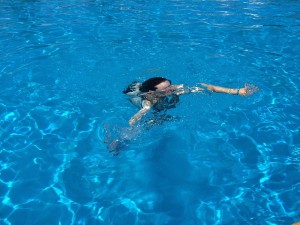Swimming in the Deep End
 Recently, a colleague commented that she admired the quality work that I am able to get my students to accomplish. She continued by telling me that she often feels as if she were watching me swim in the deep end while she is hugging the edge of the pool while wearing a life preserver. Concerning the pedagogical strategy we were discussing, her observation was accurate. But that is not the entire story.
Recently, a colleague commented that she admired the quality work that I am able to get my students to accomplish. She continued by telling me that she often feels as if she were watching me swim in the deep end while she is hugging the edge of the pool while wearing a life preserver. Concerning the pedagogical strategy we were discussing, her observation was accurate. But that is not the entire story.
I often watch my very dedicated colleague swim in the deep end as I clutch the edge. I cannot hope to get the quality work from my students that her students are able to produce under her guidance.
I am very grateful that my colleague’s leadership skills have facilitated various campus events; events I have neither the skill nor temperament to organize. Students at our college profit from her commitment to quality education and her willingness to venture into the deep end while most of us depend on our life preservers while watching her swim.
Students in my classes learn important skills that they do not have the opportunity to learn in most of the other classes they take. But, if all faculty members taught like I did, students would obtain neither the quality education nor the transformative experience a college education offers.
First, not all students are well suited for the radically student centered type of classes I teach. Many need the structure that some of my valued colleagues provide. Other students find that some quality courses taught by colleagues are too rigid and welcome the freedom I offer to them. We cannot each be all things to all students.
The second issue is that I cannot adequately teach all of the skills students need for success. I do what I do very well. But I am not very good at covering the skills that my colleague incorporates into her classes. Students need to swim in the deep end with both of us—as well as our others who excel using pedagogical approaches very different from our own.
Several years ago, I had a student who really liked my teaching style and did very well in the course he had taken with me. I enjoyed working with him throughout the semester. However, because he wanted to be a high school history teacher, I told him that he should not enroll in any other history courses I taught. As a future history teacher, he needed to be exposed to a variety of approaches to the study of history and he could only get that exposure by enrolling in classes that were taught by professors whose approach was different from mine.
Too often, educational debates forget that students need to be exposed to best practices; that students are harmed if a specific best practice were to be universally adopted. In a TED talk I learned about while watching another colleague swim in the deep end, Chimamanda Adichie explains “The Dangers of a Single Story.” While we can learn valuable lessons from a single story, a single story is dangerous because it cannot give the full perspective. If, to use one of Adichie’s examples, we were to rely on the single story found in American Psycho, we would need to conclude that it is too bad that Wall Street investment bankers are serial killers.
In a recent lesson on narrative, I incorporated Adichie’s and—by extension—my colleague’s view of narrative by screening “The Dangers of a Single Story.” Yet, the course remains primarily my narrative. The narrative of my class is a valuable single story taught from the deep end of the pool, but it remains a single story that needs to be supplemented with other narratives taught from the deep ends of other pools.
It felt good to have my colleague recognize the hard work that it takes to swim in the deep end while promoting student success. But, as someone committed to quality education, I am equality excited to put on my life preserver and cheer her on while she, too, swims in the deep end.
- –Steven L. Berg, PhD
Photo Caption: Adrian Thompson
LEAVE A COMMENT